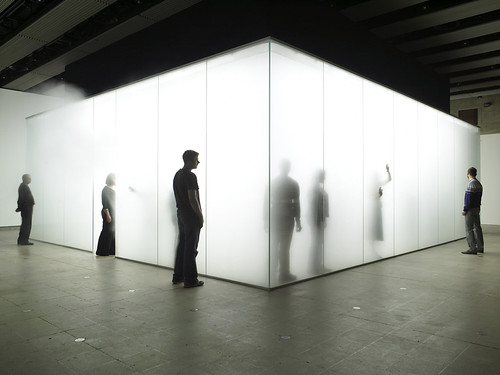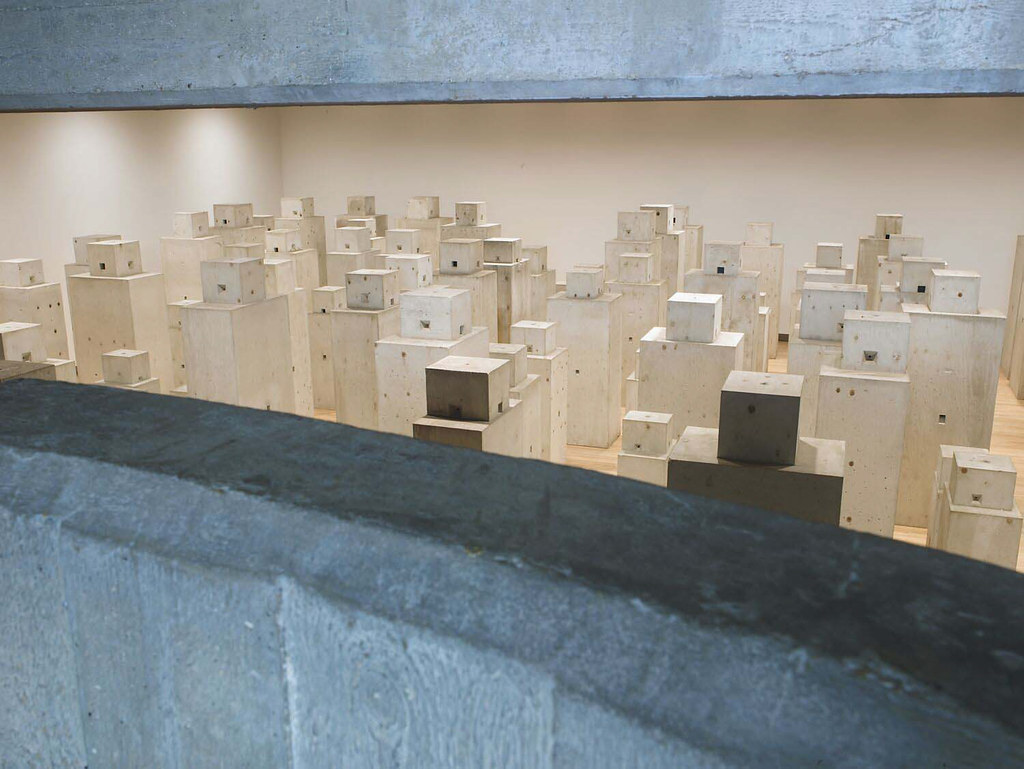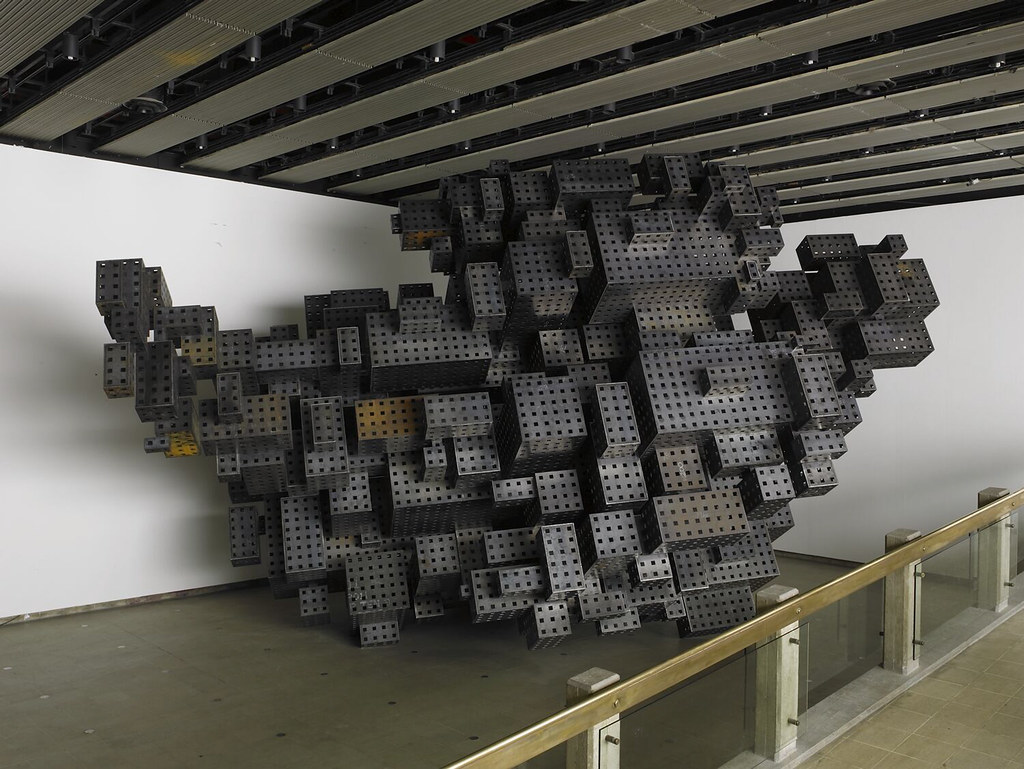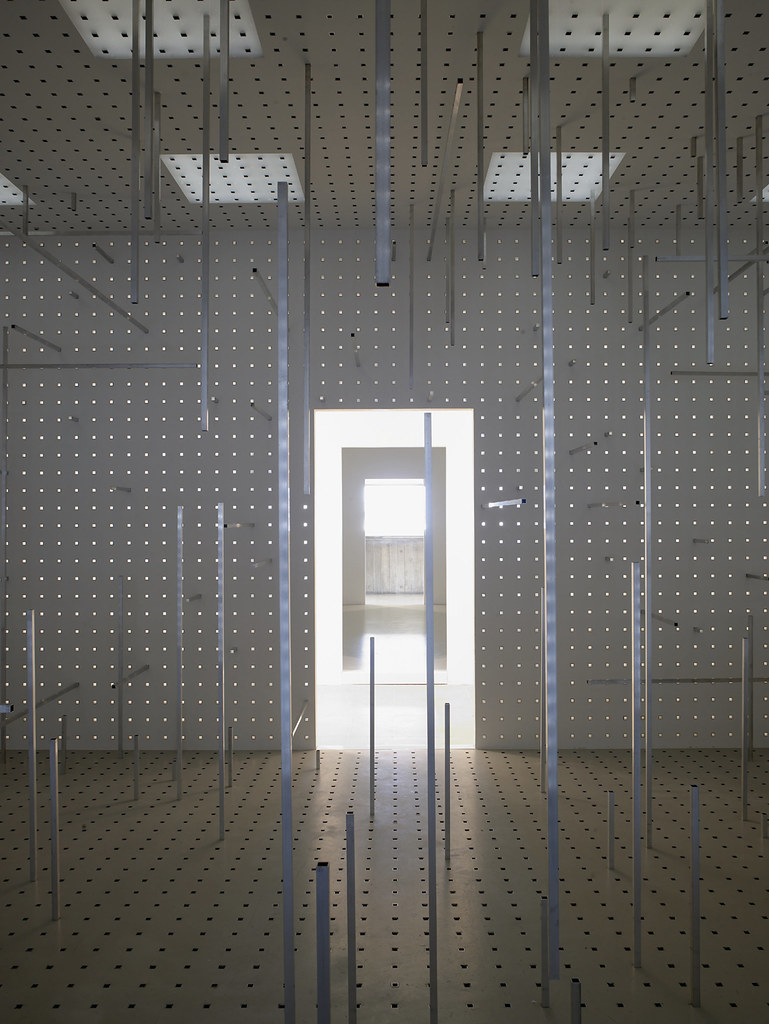Art Comments | Visual Arts Review
Blind Light: Anthony Gormley at The Hayward
written by ashley eldridge-ford in london Fending off a nasty cold this weekend, I visited the Hayward with a friend of mine from Paris. Having had to book a time slot for entry earlier in the week, I was still surprised at the number of people queuing outside the gallery. It transpired that the queue was for those unfortunates who had not had the foresight or tip-off to book in advance. So much for public spaces appealing to the spontaneity of the general public. No wonder people consider art as an elitist past time when it’s only those in the know and who know better (on the whole those already in the art world or connected to it however tenuously) and who are given the speedy right of entry. 3pm and in we go. In my humble opinion, the Hayward is a difficult space in which to show artwork.
I have seen some exhibitions that have worked extremely well in the space (Jean Lartigue and Roy Lichtenstein are two that come to mind immediately) and others not so much. I would say that for an exhibition of Gormley’s work that, the Hayward hasdone the best possible within the restrictions of the space (making use of the dead space running opposite a stairwell or a wall that sits between the door exiting on to an exterior deck and the upstairs exhibition rooms, a wall perpendicular to the stairwell). However, I would say that the main visitor attraction, Blind Light (2007), sits right bang in the middle of a raised open-plan room and somewhat detracts from the other pieces that sit in the immediate entrance space (that runs by ramp up to the raised open-plan room) to the left and also the water colour drawings that run the length of said open-plan space. This is predominantly because the main source of light emanates from said work and the eye is therefore immediately drawn to it. This piece in fact, paradoxically, dwarfs the first piece to the left of the entrance, Space Station (2007). It is a 27-ton porous corten mild steel structure that, in Gormely’s words, “conjures a dark, labyrinthine, prison-like space but also has the feeling of a sieve, of something perceptually open. Looking through the peepholes into the interior spces of the boxes, we find strange places that are disorientating yet familiar.” One is meant to see the compressed foetal form of the human body and also the collective city environment in its densest form. In part, the latter explanation is easier to interpret. Although the exhibition as a whole explores both the human body and architecture - their relation to one another and independence from one another also – this is the only piece in which I can see no emergence of both, despite Gormley’s suggestions. Architecturally, the piece reminds me of the lit windows one sees at night when living in Manhattan and it is more in the rendering in the accompanying exhibition guide that one is best able to see a layering of block-like shapes, like the ancient computer game, Tetras, that look similar to the grid-streets and apartments and offices in Manhattan. I suppose one could argue that as buildings are constructed for man that man would therefore be at the heart of all buildings and subsequently at the heart of this artwork. In all honesty, I paid this piece very little attention upon entry into the exhibition; I turned my attention rather, firstly, to the work to my right, Allotment II (1996).
Three hundred life-size reinforced concrete units are placed within one room. Each concrete block represents the individual measurements and vital statistics of the inhabitants, aged between eighteen months and eighty years, of Malmö, Sweden. I was struck by several parallels when walking between these ‘figures’. One of the thoughts was that it was like being at an art opening with all these figures filling a space but frozen in time; the other is that these ‘works of art’ are records of the individuals who took part in the project and inadvertently are pre-tombstones. Despite the stillness, the piece is filled with life. It’s partly that they represent life but also that those who were within the room found the pieces really playful. It made me realise why Gormley’s works are so loved by the public. One begins to play games: try to match your height to a concrete representation; find the smallest (the eighteen-month old); the tallest – it encourages immediate involvement. I found myself rather enjoying the process of finding a quiet corner. Would these pieces be as playful and perhaps poignant if we were not aware that they were the record of individual people? No, I don’t think so. As works of art on their own merit they are below interesting but once one knows their raison d’etre, subtle interactions between the pieces emerge and one looks to find different means by which to engage with them.
One rather dull element of this exhibition is the fact that queues play a large part of it. The queue to enter Blind Light stretched three quarters of the way around the 10 x 10 metre square enclosure. Pumped full of moist air through ultrasonic humidifiers, one cannot see more than two feet before oneself. From outside waiting to go in, it is strange to realise that the figures who emerge through the fog cannot see at all that they are as close to the glass as we can see they are. It also becomes apparent at figures walk towards and almost collide with one another, that they cannot see one another either. We are in a strange position of being able to see those who in turn cannot see. A number of people knocked on the glass or placed their hand against the glass upon realising that there were people outside looking in at them. It looked like a need for acknowledgement on their part – that there is a world outside or that they are not alone. We entered into the fog when our turn came about and we almost instantaneously lost all sense of exterior space – i.e. where the parameters were, where the exit was, where other people might be. Figures emerged from out of the fog, their arms and fingers outstretched as much as my own but we would realise our proximity to one another at the very last minute and skirt past one another. Despite being so very unaware of space, it also made us very much more aware of other people’s personal space – or the need not to enter into either theirs or them into ours. There is a fragment of a second when the chances we would intrude are likely but as the figures materialise at just the right moment; this chance collision is always just kept at bay. Even when coming into contact with the glass walls, it is really difficult to ascertain whether one is at a corner or facing a wall of glass. My friend didn’t enjoy the sensation of being lost and found that interacting with people upon happening upon them was a reassurance – that he would be able to find his way out, that he wasn’t going to succumb to the sensation of being lost forever. I rather enjoyed the moments when I disappeared and was isolated. I quite liked to stand still and let everyone else move and grope their way through the fog around me. What was curious was that outside of the glass box people had not spoken to one another in the queue but when we were all within the fogged space, we had no qualms talking with one another – excusing ourselves predominantly - girls shrieked, people laughed and called to each other. All this noise and movement within such a small space with such quiet and decorum without was fascinating. I think that people’s different reactions to being within the space make for interesting viewing and contemplation – some within held on to one another, not wanting to lose the person with whom they entered, others entered as though on military operation (thus causing my friend to tag on to their knowledgeable-sounding crew so as to guarantee swift location of the exit), others still who were quite content to walk until either a person or a glass wall stopped them. I think if one thinks about some of the issues the artworks aims to raise that it is important to recognise that the artwork does indeed comment on human beings and raises the opportunity for us to examine how we interact both within and without the space. To look at this perhaps more broadly, how, within a city, we interact within and without the spaces – buildings or openair - that we enter, pass through and exit every day. Who and what we are or become as we commute through these passages.
Another work worth noting on the ground floor is Sense (1991), a concrete geometrical block in which concrete has been formed around a life-size wax mould of the artists body using the ‘lost wax’ casting technique. Once the wax had melted and poured out, a body-shaped void was left within the block. Looking down into the block allows us to only see what would be the crown of the head, the space the head would occupy and then the darkness in which the body shaped cavity had been recorded. The only visible imprint is left by the hands pushing up against the side of the block against which the artist had been hunkering down and pressing his face against, so to speak.
The second floor galleries have some interesting works on show. There are a number that are not what I would choose to remember or discuss but Matrices and Expansions (2006 – 07) are works that I would. Created from stainless steel, Gormley has taken the human figure as the nucleus and axis out from which extend what look like geometric grids and lines that create striking polyheydron patterns in space – suspended geometric drawings. They are really hard to describe and Gormley in fact explains them rather well, ‘Neither architecture not anatomy’, they are ‘more like the random matrices found in fractal geometry.’ He calls them the “bubble matrix” series and has stated that this ‘is the closest I get to Brancusi’s notion that you can turn an object into light. He did it by polishing sculptures, whereas I have tried to do it by abandoning weight and mass and dissolving surface.’ The pieces are excellently crafted and thought through. The central figures can take a little time to emerge and are beautifully surprising when they do. Perhaps these pieces comment more on the space surrounding them, the space taken up by a dynamism suggested by the lines emanating from them of which they are the source. It is, of course, however, the lack of a solid body at the centre but merely its suggestion that begs the question of whether these transmissions relate to the energy we transmit and our imprint on the space around us. The photographs, Quads (1979 – 2007) were of interest because it was possible on occasion to see where Gormley may have gleaned some of the ideas for pieces in the exhibition. Drawn (2000/7) was a playful piece with eight identical figures legs spread-eagle and arms raised directly above the head. The figures appear to be holding the ceiling and floor in place, pushing against both and placed with each of the four corners of the room. I would very much have liked to have seen Hatch (2007) but again, the queue wound three quarters around the room and I couldn’t face another queue. Perhaps because I didn’t experience it from the inside this piece has left me cold; it has been created so called ‘porous’ in that endoscopic tubes act like maze walls around which a visitor inside must navigate whilst being spied on through these tubes by those standing (and waiting) outside. Without having been within, I found this piece quite disinteresting.
Finally, outside of the Hayward Gallery there was an extremely interesting commissioned installations involving the city of London: life-size figure casts of Gormley’s body are placed on rooftops and walkways both north and south of the Thames over a 1.5 sq kilometre area. All the figures face toward the gallery’s sculpture terraces, which act as viewing platforms. Whereas one might take a look at the city of London from these terraces on a visit to the Hayward, this installation encourages and inspires one to interact with the city and one’s surrounds. These solitary and still figures in a bustling and crowded city create an occasion for meditation. Looking out over the vista, I found my eye was instantly on the hunt to locate as many silhouettes as I could. Of course, the more I looked, the more I saw. Where before I had looked at buildings in their own right, on this occasion the buildings served no other purpose but to be the instrument from which to show these figures - like plinths. It leads one to consider the function of architecture – the importance of the human figure in their configuration, design and construction. These buildings that were constructed to house the human form are here supporting a representation of them. I began to think about our influence on the design and construction of buildings – the importance of our dimensions in their construction in either grand buildings or small ones – from the attention to detail – a door handle, or the lip of a step, the manner in which two walls meet. These details may have been designed for the architect’s pleasure but they are still designed to please the human eye. All that is exterior that we experience has relevance and can be referenced to us because we are experiencing it. We are as much at the centre of all we see and do as we choose to be and perhaps more so.

View of Event Horizon, part of Antony Gormley: Blind Light with The Hayward.
Photo Credit: Gautier Deblonde
I had not anticipated that I would find so much to provoke my thoughts and the exhibition is good in two ways: a means to entertain the family and the kids on a Saturday afternoon but also as an occasion in which to stop and think – without sounding too trite - about our daily existence within architectural structures, our existence within a city, within our bodies. These are each ‘houses’ through which we pass and we left the exhibition with much to discuss, taking the conversation and discussion home to my architect boyfriend.
Anthony Gormley
Blind Light
Jake and Dinos Chapman at Tate Britan
David Lynch in Paris at the Foundation Cartier





Comments
Giovanni Palatucci
VOLTURARESE NEWSPAPER italy
Monthly Information
The Volturarese Newspaper, after the discovery of the unpublished
Picture, Which is
Volturara Irpina ( AV ) article, after being transmitted by the BBC
program and the
Italian mass media about the new appearance of the Monster of Loch Ness
( Scotland)
Necessary needs to inform the whole world that the Holland Painter and
engraver
M.C.Escher had already painted and announced the new reappearance,
recalled by the
Black Man without a Face.
And with what has been written above, with peaceful intentions:
1) either Escher had seen personally the monster of Loch Ness while he
was wandering
about;
2) or Escher believed that the monster of Loch Ness really existed and
thats why he
did the drawing.
This work of art is dated 01.18.1949.
The Handwriting consultation is made of 51 pages and has been sworn and
registered at
The Court of R O M E in the date of august 4 .2006. This is a big
discovery for the
World of art. The Republic power of Attorney,of Avellino is
even occupying about
This case, interested has for the Policeman who is the owner of this
Picture. Holland denies
The existence of this unpublished Picture without seeing it or
examining it .
Honour and glory to Escher, the Loch Ness Monster,to everybody Irpine
and the national
And international Mass media that will publish this HISTORICAL EVENT.
The Association President
Michelangelo MARRA
Internet :
http://www.romanzieri.com/archives/001204.php
http://www.ladysilvia.it/magaView/news/8885/arte
http://www.amicidellapolizia.it/html/arte.htm
http://www.ladysilvia.it/magaView/news/7869/arte
http://otrale.blog.tiscali.it/dg2044158/
http://www.ladysilvia.it/magaView/news/7662/cronaca
http://www.irpinianews.it/DaiComuni/news/?news=19596
http://notiziario-volturara.blogspot.com/
http://telegolfonews.blogspot.com/2007/07/n-e-s-s-u-n-o-n-e-p-r-l.html
http://www.fimservice.it/pdf/pol_dic06.pdf
http://fr.dada.net/video/1311677/nessie-the-dragon/
http://www.horrormagazine.it/forum/viewtopic.php?t=5312
http://www.fimservice.it/pdf/pol-lugAgSet07.pdf
http://www.napoli.com/stamparticolo.php?articolo=13464